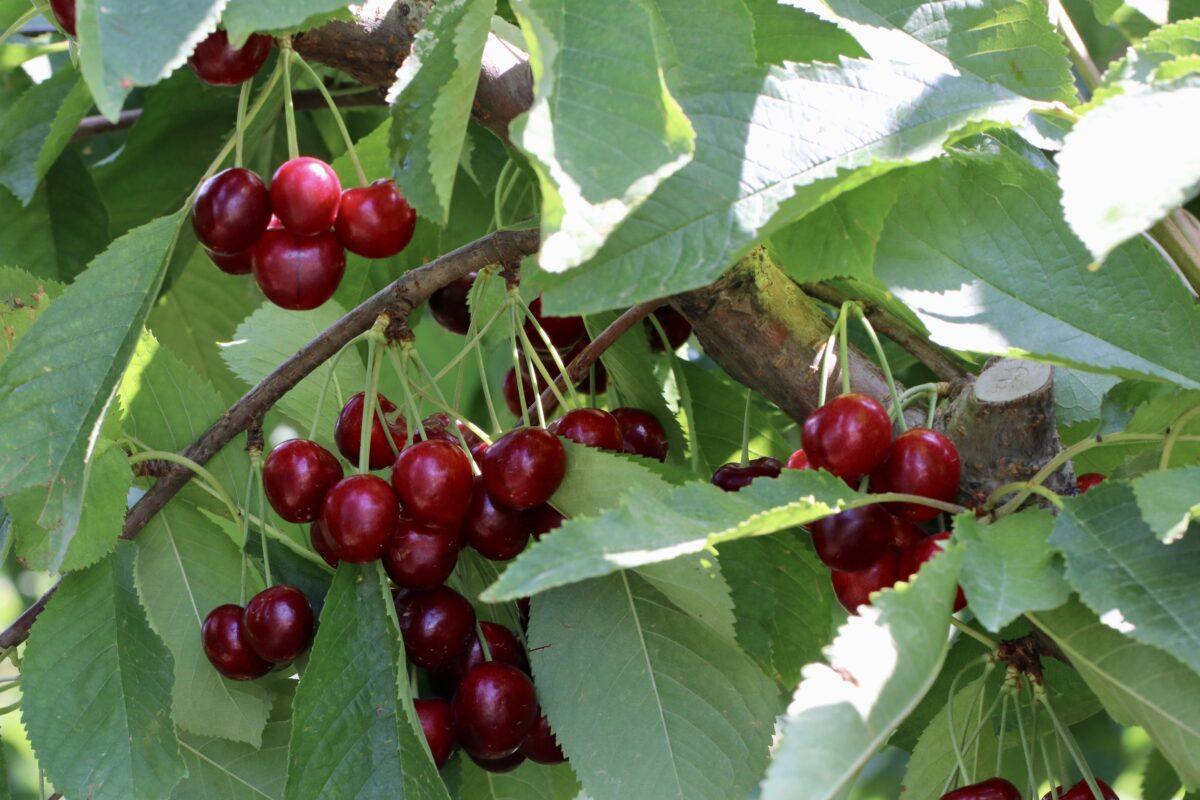How Rainfall Affects Cherry Crops

Nobody in Chelan looks forward to summer rain. Tourists dread it will ruin their day on the lake, while cherry farmers fear it will spoil their crops. Understanding how rainfall affects cherry crops is crucial for anyone at Lake Chelan during the summer.
Heavy rain can lead to cracking or splitting in cherries, directly damaging the fruit or causing powdery mildew infections that may also damage the fruit. At Chelan Ranch, we farm organically and use irrigation systems, minimizing our reliance on rainfall. However, managing the impact of summer showers is vital for both organic and conventional cherry farmers. Following a rainfall event, numerous helicopters are common in the skies over Chelan as helicopters fly to dry the cherry trees and prevent moisture-related issues. I’ll share how each approach tackles this challenge.
Water Requirements for Cherry Trees

Both organic and conventional cherry farmers agree that a balanced water supply is essential for healthy cherry trees. Typically, cherry trees require about 1 to 2 inches of water per week during the growing season, depending on soil type and climatic conditions. Both organic and conventional farmers watch the forecast and decrease water applications if rainfall is anticipated to prevent excessive moisture absorption that leads to cracking. However, mitigating the effects of rainfall can vary significantly between the two farming methods.
Impact of Excessive Rainfall

Organic Farming:
- Fruit Cracking:
- Prevention: Organic farmers use natural methods to prevent fruit cracking. At Chelan Ranch, we closely monitor our cherry orchard to ensure the highest quality fruit. As soon as the cherries turn a straw color, we know they are at risk of cracking if exposed to prolonged moisture. We keep a vigilant eye on the weather forecast and take proactive measures to protect our crop. Regularly mowing the orchard grass helps to minimize humidity levels, while diligent inspections of the tree canopy allow us to catch any signs of powdery mildew early. Through these careful practices, we maintain the health and integrity of our organic cherries.
- Drying Process: We contract helicopter service to be on call at the local airport and available immediately if it rains. When we think the rain has stopped, we contact the helicopter service and get in line for drying. It’s a first-call, first-service arrangement. When the helicopter arrives, it hovers above the orchard canopy, mere feet above the cherry trees. Our ground team begins blowing when the cherries are wet. Unlike the helicopter, the ground blowing occurs day or night after the rain starts. Helicopters only fly during daylight hours. With this upper-lower approach, we’ve successfully dried our cherries before cracks appear, which can take long days. For this reason, we have a night and day crew that alternates between day and night.
- Mildew Infection:
- Organic farmers rely on natural and preventative measures, which can be effective but often require more effort and careful management.
- Improve Air Circulation: Prune trees to enhance airflow and reduce humidity levels around the foliage.
- Monitor and Apply Fungicides: Regularly monitor for signs of infection and apply sulfur, a natural fungicide, before or immediately after rain events.
- Remove Infected Plant Material: Promptly remove and destroy infected plant material to reduce the source of spores.
- Proper Irrigation Practices: Use drip irrigation instead of overhead watering to keep the foliage dry.
- Organic farmers rely on natural and preventative measures, which can be effective but often require more effort and careful management.
- Nutrient Management:
- Natural Fertilizers: Organic farmers use compost and manure, which release nutrients slowly and are less likely to be washed away by heavy rains. Increased organic matter improves soil structure and drainage, helping to manage excessive moisture.
Conventional Farming:
- Fruit Cracking:
- Chemical Treatments: Conventional farmers often rely on chemical treatments to strengthen the fruit skin and reduce cracking.
- Anti-Transpirants form a protective coating on the fruit skin, reducing water absorption. Spraying a thin film over the fruit surface using products like Vapor Gard or Transfilm is a popular choice.
- Silicon: Foliar sprays containing silicon reinforce cell walls and increase the toughness of the fruit skin, making it less prone to cracking.
- Surfactants: help spread water evenly over the fruit surface, reducing localized pressure points that can lead to cracking.
- Drying Process: Like our organic cherry farming, conventional growers also contract with a helicopter service to dry all cherry acreage during the growing season.
- Chemical Treatments: Conventional farmers often rely on chemical treatments to strengthen the fruit skin and reduce cracking.
- Mildew Infection:
- Chemical Fungicides & Synthetic Treatments: Powdery mildew is a manageable disease due to the availability of potent chemical fungicides and systemic treatments, for example, myclobutanil and azoxystrobin. These tools provide an immediate and robust defense against mildew, reducing the labor and complexity involved in disease management. However, this approach has drawbacks such as chemical resistance, environmental impact, and potential health concerns.
- Nutrient Management:
- Chemical Fertilizers: Conventional farming often uses chemical fertilizers, which can be more susceptible to leaching during heavy rains. Petroleum-based fertilizers require precise application and timing to minimize nutrient loss and prevent contamination of water sources.

Rainfall significantly impacts cherry crops, and both organic and conventional farmers have developed strategies to mitigate these effects. Organic farming emphasizes preventative measures that involve skilled management and labor, soil health, and natural methods, while conventional farming relies on technological advancements and immediate chemical interventions. Each approach has merits and challenges, and the choice often depends on the farmer’s goals, resources, and values.

At Chelan Ranch, our goals include sustainable farming, producing high-quality, unadulterated organic cherries, and engaging with our community. We leverage resources such as our irrigation system, organic inputs, fruit tree monitoring and management, and advanced drying technology while upholding our values of environmental stewardship, health and well-being, transparency, and community relationships.